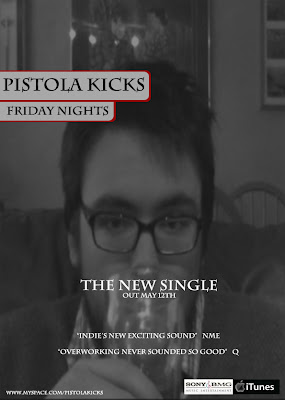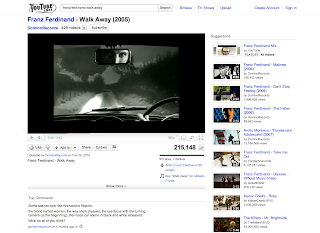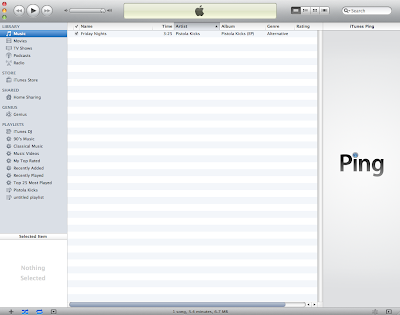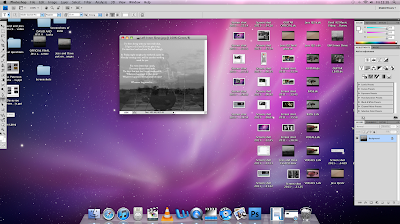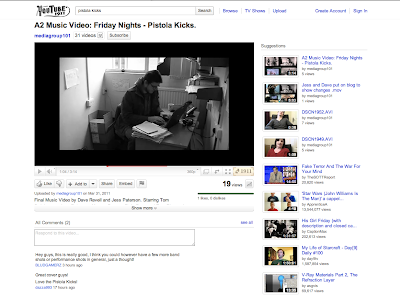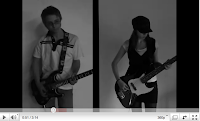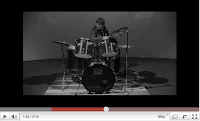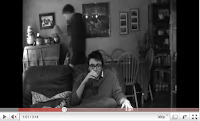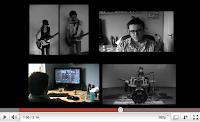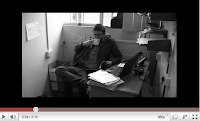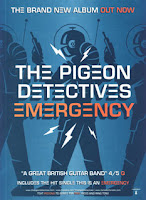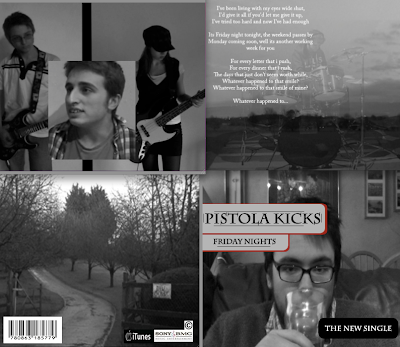Here is our final music video. After watching the improved verson with the better performance shots I noticed that the vocalist appearing randomly for a few seconds looked odd and although the actor was singing, he was over pronouncing the words which looked badly out of synch. I also noticed the extent to which the movement of the drumming shot in the four split screen effected the media text. The performance shots were also very dark and needed to be lightened. After consulting with David the changes were made and here is our final outcome.
Tuesday 5 April 2011
Final Ancillary Tasks:
Magazine Advert:
This is our final magazine advert that would be located in NME. We got inspiration from The Artic Monkeys and various other Indie bands. This was not changed following our audience feedback as there was no need.
Digi-Pack:
This is our final Digi-pack. Following our audience feedback we thought it was best to change the inner sleves from images taken from the internet to stills from our music video. We kept the band/performance shots idea though and included the lyrics again as this is effective.
This is our final magazine advert that would be located in NME. We got inspiration from The Artic Monkeys and various other Indie bands. This was not changed following our audience feedback as there was no need.
Digi-Pack:
This is our final Digi-pack. Following our audience feedback we thought it was best to change the inner sleves from images taken from the internet to stills from our music video. We kept the band/performance shots idea though and included the lyrics again as this is effective.
Thursday 31 March 2011
Evaluation Question 4: How did you use new media technologies in the construction, research and planning and evaluation stages?
Throughout the process of creating our promotional pack we have used new media technologies. Whilst research and planning we used YouTube to view similar texts in order to get inspiration for our own. This is an activity usually associated with web 1.0 but YouTube is a web 2.0 media technology. This is because people create content, upload it and create new audiences. YouTube uploaders are prosumers and so are we but at this stage we were viewers. We were then able to embed the videos into our blogs via a computer code much like a web address which is unique to each video. We used this to illustrate how these videos have influenced us. We also used the social networking website MySpace to do research into the band and how they represent themselves. This helped us with our promotional pack in making it appeal to its audience. Other websites including institutions as well as fan sites were used to see what attracts them about the Indie genre. This was part of our audience research. The internet is not a new media technology as such but was crucial for our research stages. When it came to research for our ancillary tasks we took photos and uploaded them onto our blog. This involved computer software that connects one piece of technology [camera] to another [computer] using a lead. I did this at home. We also scanned in adverts from magazines. All these are new technologies that have made our research possible.
In the planning stages we used new media technologies too. Our main planning consisted of sketching and notes on paper which were then scanned onto the Mac and uploaded onto the blog. This is evident though our storyboard and my bass tabs. The process of scanning something onto a computer is quite new and has made the process of planning much easier for us. The process of figuring out a bassline and playing it is a planning stage in itself. We used electronic planning sheets which were then scanned uploaded on the blog. These were done on Microsoft Word and then made screenshots and uploaded onto the blog as photos.
In the construction stages we used ITunes to download the song onto our IPods [or in David’s case mobile phone.] To get the song onto the Mac we used Bluetooth which wirelessly connects one electronic equipment to another through signals. This is shown as a small symbol on the top of the desktop. This is a relatively new technology which has enabled us to place the song onto the desktop without buying the song once more on ITunes. I used a CD with the song burned on it and imported it to my ITunes library in order to create in time performance shots. This was made possible by Bluetoothing the original copy of the song onto the school’s Mac and burning it onto a disk. This is also a new media activity enabled by ITunes. In the filming process we used SD cameras that record videos and take photos. We mainly used these for getting the footage and uploaded the footage onto the Mac using ISquint. This is a free piece of opensource software that enables users to find and change the source code to suit their needs. This is very new piece of media technology that is part of web 2.0 as users can edit existing software and in tern make new audiences through the media text that is made. The editing software we used for the music video is called Final Cut Express and it has all kinds of tools to make videos. These include fades, colour changing and split screens. We used this software to choose the footage we wanted to use and place it on the timeline linking appropriate footage with effects such as fades and layering. This is how we made our music video conventionally Indie through experimental styles. To create our ancillary texts we used an image editing software called Photoshop. This enabled us to import screenshots from our music video and include them in our Digi-pack and Magazine advert. Once the images were there we could add text and other images in order to create the whole media text. This is evident in our Digi-pack as we have a screenshot for the background image and other images on top such as the Sony BMG logo and a barcode.
Once our promotional pack was complete we uploaded the music video to Youtube. This made us prosumers as we no longer were viewers but text creators too. This is because we started with an existing text, the song, which we then interpreted to create our promotional pack. We then got comments from our audience which in tern created a new subgroup audience identity.
Through the evaluation stages we have used similar new media technologies to the previous stages. We took screenshots from our music video, audience feedback and inspiration as well as our ancillary tasks which were then imported as photos. We did this to illustrate the points made. We also took screenshots of websites and other means of research we used. Question two was made in a similar way to the music video. We filmed ourselves speaking from a script and uploaded the footage using ISquint. We also imported our final music video and added screenshots of inspiration or our ancillary tasks onto the timeline whilst the music played in the background. This was done in Final Cut Express.
Evaluation Question 3: What have you learnt from your audience feedback?
For our audience research we thought of the typecast Indie kid who would be interested in our promotional pack. We then researched this and Indie fashion which was then backed up by Indie music fan sites. We discovered that Indie kids like their music videos experimental yet meaningful. We also discovered that Indie music fans can be any age and not just teenagers in skinny black jeans. By researching Indie media texts we got a good idea about our audience as these texts had to appeal to their audience in order to sell the song. These showed that our audience like narrative videos as well as performance ones but in order to really appeal to them we learnt that a combination of performance and narrative shots was needed. Our promotional package was then based on this profile.
As we knew who our promotional package was aimed at we uploaded our music video in a place where they would find it - Youtube! This was hinted by the fact that the fan made music video for 'A Button Like No Other' was found here. Youtube is the place where people watch and publish media texts for the world to see be they institutions or prosumers like us. We got two comments from Pistola Kick's fans which we then used to change our music video. These comments were mainly about the performance shots. One fan suggested more performance shots were needed and feedback from people around us suggested that our framing and mise-en-scene could be improved. As a result we included more performance shots with every member of the band. Locations were planned and so were costumes although we did not use the conventional Indie outfit of black skinny jeans with jackets. Instead the musicians were wearing jeans, shirts and Jack Wills. These are also conventions of Indie attire but are less common than the typecast skinny jeans and leather jackets.
We also showed Indie music fans our promotional pack, including the ancillary tasks. They liked the music video, especially the combination of performance and narrative shots but thought the performance shots were ineffective due to the obvious classroom location. They liked our ancillary tasks too, especially the front and back cover. However, they saw no link with the inner sleeve images to the music video and this is what they did not like. Despite this they thought the use of lyrics was effective so we included this in our changed ancillary tasks along with new shots of musicians whilst creating an experimental style. They liked this much better. This makes our promotional pack was successful when attracting the audience.
As we knew who our promotional package was aimed at we uploaded our music video in a place where they would find it - Youtube! This was hinted by the fact that the fan made music video for 'A Button Like No Other' was found here. Youtube is the place where people watch and publish media texts for the world to see be they institutions or prosumers like us. We got two comments from Pistola Kick's fans which we then used to change our music video. These comments were mainly about the performance shots. One fan suggested more performance shots were needed and feedback from people around us suggested that our framing and mise-en-scene could be improved. As a result we included more performance shots with every member of the band. Locations were planned and so were costumes although we did not use the conventional Indie outfit of black skinny jeans with jackets. Instead the musicians were wearing jeans, shirts and Jack Wills. These are also conventions of Indie attire but are less common than the typecast skinny jeans and leather jackets.
We also showed Indie music fans our promotional pack, including the ancillary tasks. They liked the music video, especially the combination of performance and narrative shots but thought the performance shots were ineffective due to the obvious classroom location. They liked our ancillary tasks too, especially the front and back cover. However, they saw no link with the inner sleeve images to the music video and this is what they did not like. Despite this they thought the use of lyrics was effective so we included this in our changed ancillary tasks along with new shots of musicians whilst creating an experimental style. They liked this much better. This makes our promotional pack was successful when attracting the audience.
Evaluation Question 2: How effective is the combination of your main product and ancillary texts?
David: We have created a Music Video, Magazine advert and Digipack for the song ‘Friday Nights’ by the’ Pistola Kicks’ who are an indie/alternative genre. The Cinematography that we used within the video is very stereotypically conventional of the genre, and appeals directly to the target audience. We feel that the close ups of the protagonist’s face (such as when he is drinking the beer) mixed with the high angle shots of the instruments (guitar, bass, drums) are all very effective in attracting the target audience, as they are similar in relation to other comparable texts such as ‘The Killers’ video to their song ‘A Dust-land Fairytale’. Furthermore; black and white coloring is a very typical convention of the indie genre, many videos by ‘The Arctic Monkeys’ and ‘The Pigeon Detectives’ use this technique, and they influenced us to implement the idea into our own work. This is effective because it helps connote the Narrative of the song, and also denotes common themes associated with indie songs and/or videos such as lack of satisfaction, hopelessness and boredom.
Jess: We also over-laid some of the instrument shots over others, to help create the experimental style that the indie genre is typically known for. This is also very effective in attracted the target audience.
Mise-en-scène is also used effectively within our video and also linked into our Digipack and Magazine advert to help connote the protagonist’s emotions and character. His costume is very scruffy and represents that he is not bothered about his appearance, which is further denoted by his large beard. This all connotes that he is a very unkempt character, which is again typical of the characters within the indie genre, and would help attract the audience.
David: Our texts are also very effective in appealing to institutions. The institution we chose to market our Promotional pack was Sony BMG. This is because we researched into other music producers such as EMI, and Sony BMG was much more suited to the indie genre, having produced artists of a similar genre. This would also appeal to the target audience because they would recognize the associated logo with other songs that they like.
Jess: In addition to this; the inclusion of screenshots from the video used in the Digipack and Magazine advert is effective in relating all the packages together. Therefore there is a common theme throughout and the audience who have seen the video would instantly recognize the CD and Advert. The themes denoted are similar to other artists work, for instance dejection and loneliness. The link between the three texts is also effective in pleasing the institution. This is because the audience would recognize the link to the video and being more likely to purchase the product.
David: After uploading our video to Youtube.com and posting it on Facebook, we had some constructive criticism (which was welcomed) from our target audience. We uploaded the original video, but after the responses, we found it necessary to improve some of the scenes and add in some extra footage. The criticism was generally in correlation to the performance shots; the guitar, bass and drum scenes as well as the vocal scenes.
Jess: We discovered that not only was the performance not well executed, but also the mise-en-scene was not well planned and could be made better with different locations and well planned costume. After the changes we feel that the combination of the main task and the ancillary tasks is now much more effective, as we can implement the new shots in our research and planning of our ancillary tasks, as well as the ancillaries themselves; rather than images taken from the internet.
Evaluation Question 1: In what ways does your media product use, develop or challenge forms and conventions of real media products?
By using a combination of performance and narrative shots our promotional package is conventionally Indie as many Indie bands use this technique. For example, Franz Ferdinand has done this with many of their music videos including 'The Dark of the Matinee', 'Michael' and 'Walk Away.' Even The Pigeon Detectives have used this technique in their music video for 'I'm Not Sorry.' However, these artists have used group performances as well as individual ones. We have challenged this convention as our performance shots are of individual musicians instead of the band as a whole. This worked in other media texts such as the music video for ‘Meanwhile’ by Mystery Jets so we thought it would be suitable for our music video too. These shots are synced with the music and are relevant to the specific bits of the song. For example, when rhythm guitar is most prominent in the song a rhythm guitar is shown. This is used in some Indie music videos but not many. Franz Ferdinand use this quite a lot, especially in the music video for 'Micheal' and The Futureheads used these kinds of shots in their video for 'Meantime' too. It is conventional to use a mixture of performance and narrative shots in digi-packs too. As a result we have used two performance and two narrative screenshots as images for our digi-pack. This convention is common for Indie music videos with a narrative as it gives the music a face and branding through featuring the band. This is because the audience would recognise the band members when they see the music video which would make the music video appeal to its audience which would also be attractive to institutions too. Institutions like to make money and in order for this to happen the audience must like a media text and recognise the music and band.
Indie promotional packs are very experimental in style, especially music videos and so is ours. The long shot of the protagonist walking sped up in the corridor may seem a little random. This is deliberate as we have used the experimental convention of Indie in order to make our promotional package appeal to its audience. Sped up shots are common in the Indie genre. We have also used this convention when creating the split screens. Split screens are often used in Indie music videos as proved by Mystery Jets and the video for their song 'Meanwhile.' Our four split screen shot was inspired by the past A2 music video for The Vixens song ‘Voodoo Child’ especially when the protagonist looks towards the space where the next shot appears. However, we have developed this technique by using many types of split screens. These include vertical splits and diagonal squares. We have even challenged a convention here as in individual shots in split screens are usually pure narrative or performance, as proved by Mystery Jets. On the other hand, ours combined narrative and performance shots which were then linked by the protagonist’s glances [when he looked in a direction shots appeared.] This is rarely used in Indie. We continued this with our ancillary tasks when the split screens were used as images for our Digi-packs. Other music videos that are experimental are 'Show Me the Light' by Mystery Jets and 'Micheal' by Franz Ferdinand. However, these music videos use ghostly effects rather than split screens.

Our promotional package both used and developed the form and convention of lipsyching. Indie music videos [and most music videos for that matter] are lipsynched to make it look like the mimer is singing be he/she an actor or a band member or both. To make our music video look professional and appeal to its audience and institution we did the same thing. We have challenged the Indie convention of including the lead singer in our performance shots as the protagonist is singing instead. This is very atypical for an Indie media text. We have also challenged this convention as the protagonist is also singing as well as playing the guitar. This is unconventional for an Indie music video as it combines narrative and performance shots in an exciting way thus making the song represent the character more. This means there is two people playing the same guitar tabs. This is uncommon in Indie media texts yet worked well with ours when linking the protagonist to the song through sound as well as mise-en-scene. We also challenged the conventions of Indie through combining narrative and performance shots through layering. This created an almost ghostly effect similar to that in the Franz Ferdinand video for 'Micheal.' This effect was also used in the music video for Disturbed's song 'Voices.' However, this convention is more common in the Heavy Metal genre. Examples of this can be found in most of the music videos I researched such as 'Show Me The Light' by Mystery Jets. This was very effective and worked well with the video whilst appealing to the audience as Indie fans like their music [and music videos] meaningful but experimental. This in unconventional for an Indie music video but works be because of the experimental style of editing in which those shots are used. This is conventional of the Indie genre so would be recognised by Pistola Kick's audience including those who made the music video for 'A Button Like No Other.'
By making our narrative and performance shots black and white we have used an Indie convention. Many Indie media texts are in black and white, this includes ‘I’m Not Sorry’ by The Pigeon Detectives and ‘Dark of the Matinee’ by Franz Ferdinand. However, just as many are in colour too such as ‘Meanwhile’ by Mystery Jets. We have also used the convention of making our performance shots black and white too as it suited the narrative best just like the Pigeon Detectives music video. The slow motion effects help here too when creating a lack of satisfaction vibe. These camera shots with slow motion editing are realistic; this gives our promotional package a sense of realism. This is because these feelings can be felt and people do drink beer slowly sitting in front of the television. However, we have developed the conventions of a narrative based promotional pack as a few shots are set in an office. This is very realistic and a non-conventional place to locate a music video. This type of setting is used more often in other genres such as Heavy Metal as proved by the music video for Disturbed’s song ‘Voices.’ Despite this, some Indie promotional packs can be depressing depending on the song. A perfect example of this is the music video for ‘I’m Not Sorry.’
We have also used the convention of linking all three parts of the promotional package: the music video, digi-pack and magazine advert. These are usually linked through theme. We have done this by making the background to the magazine advert the frontpage of the digi-pack which was a still from the music video. This is conventional of the Indie genre as the magazine adverts I found had the album cover as the background image. This was the case with The Pidgeon Detectives, Kings of Leon and Artic Monkeys. However, I cannot say whether this is the case with singles as I could not find any such magazine adverts. But we looked at single digi-pack covers and the My Chemical Romance single digi-pack cover for 'I Don't Love You.' The cover is a screenshot from the music video. This suggests that it could be same for Indie single digi-packs and henceforth magazine adverts too.
31/03/11:
The filming is finally done! Drumming and vocals can now add to the timeline to fill in the blanks. This happened at lunch. Meanwhile in the lesson the rest of the video was completed including the tricky four split screen [or can I now say five?] After school I plan to slot in and edit the rest, change the ancillary tasks and film for evaluation question 2.
The music video is now complete and so are the ancillary tasks with the much needed changes.
The music video is now complete and so are the ancillary tasks with the much needed changes.
Wednesday 30 March 2011
30/03/11:
Today I practiced the bass line for the song over and over again so I could perform it right when it comes to filming it later on today. I got blisters on my plucking hand [I prefer not to use plectrums] yet I would be able to play later, write and type. That is "Bass instinct" for you.
Tuesday 29 March 2011
29/03/2011:
Today I planned to upload and edit the footage I filmed the other day. However, I realised just how badly framed the shots really are. To add to this the cinematographer [my friend] is not very video camera literate and missed the good guitar solo shot. However, she is more steady handed than me. As a result it would be best to film everything tomorrow, upload and edit it and place certain shots in our digi-pack. In the meanwhile I will work on my evaluation.
Monday 28 March 2011
28/03/11:
Today we uploaded the music video to Youtube and will post the link on both our Facebook accounts in order to get feedback from our audience. We will then use this feedback to change our music video if needed. We also worked on our script for evaluation question 2.
Wednesday 23 March 2011
Music Video:
Here is our music video with the much needed performance shots changes. We have added guitar, drums, bass and vocals whilst replacing the existing performance shots with better mise-en-scene and framing. This makes our music video much better quality and more conventionally Indie at the same time due to the effects we have added such as extra split screens.
Here is our music video before with the poorly planned and executed performance shots. There is a lack of variety here and the lack of planned mise-en-scene looks terrible. By making simple changes we have transformed our music video.
However, before we could submit our first draft of the music video we discovered a minor problem. The beginning credits/information was copied over a three split screen instead of a drumming shot. My surname was also spelled wrong. These were easily corrected.
Ancillary Tasks:
Here are our Ancillary tasks. As you can see we have replaced the internet images with stills from our improved music video. This has effected the Digi-pack but not the Magazine advert.
Here is what our Digi-pack looked like before the changes.
Trouble and Plans:
AS THIS WAS THE FIRST TIME I HAVE EVER ORGANISED SOMETHING IMPORTANT VERY LAST MINUTE [THE FILMING ONLY CAME TO LIGHT ON TUESDAY THIS WEEK DURING BAND PRACTICE] I HAVE DONE LOTS OF RESEARCH AND PLANNING INTO MISE-EN-SCENE AND CINEMATOGRAPHY IN ORDER TO MAKE THESE SHOTS ARE AS GOOD AS THEY CAN BE. HOWEVER, I HAVE NOT DONE SO WELL ON THE ORGANISATION FRONT [AND NEVER DO.]
I planned the location but did not know when it opened and closed or how to contact them. This hindered me as I only discovered that the studio is only open on Tuesdays and Wednesdays. To add to my frustration the number that Bradley gave me went to answer phone each time I rung. This means that there will most likely be no filming tomorrow unless I find a different location [which I am struggling with.] This means that we will probably have to work on the evaluation until Tuesday and add the shots in later to our music video, ancillary tasks and evaluation. This would require some time out of school but I am willing to do this to achieve my target grade and personal aims.
This Friday, Saturday and Sunday [the rest of this week] I will work on evaluations.
Thursday 24th March:
The deadline for the evaluation is creeping closer which means there is no time for luxuries such as waiting for The Croft. Instead I have found a more accessible location. I have got together a group of people [after a massive panic attack during lunchtime] and we will film asap. There would be lighting and no group band shots but shots of instruments instead. I feel this is more appropriate considering the current timescale.
Friday 25th March:
Yesterday I emailed a lighting expert in school about filming in a room which looks very similar to a studio as this location is more accessible than The Croft or places like it. Unfortunately after speaking to my Applied Business teacher I discovered that my lunchtime lesson is unmissable so had to rearrange to Monday lunchtime. Here are his replies:
I planned the location but did not know when it opened and closed or how to contact them. This hindered me as I only discovered that the studio is only open on Tuesdays and Wednesdays. To add to my frustration the number that Bradley gave me went to answer phone each time I rung. This means that there will most likely be no filming tomorrow unless I find a different location [which I am struggling with.] This means that we will probably have to work on the evaluation until Tuesday and add the shots in later to our music video, ancillary tasks and evaluation. This would require some time out of school but I am willing to do this to achieve my target grade and personal aims.
This Friday, Saturday and Sunday [the rest of this week] I will work on evaluations.
Thursday 24th March:
The deadline for the evaluation is creeping closer which means there is no time for luxuries such as waiting for The Croft. Instead I have found a more accessible location. I have got together a group of people [after a massive panic attack during lunchtime] and we will film asap. There would be lighting and no group band shots but shots of instruments instead. I feel this is more appropriate considering the current timescale.
Friday 25th March:
Yesterday I emailed a lighting expert in school about filming in a room which looks very similar to a studio as this location is more accessible than The Croft or places like it. Unfortunately after speaking to my Applied Business teacher I discovered that my lunchtime lesson is unmissable so had to rearrange to Monday lunchtime. Here are his replies:
Subscribe to:
Posts (Atom)
